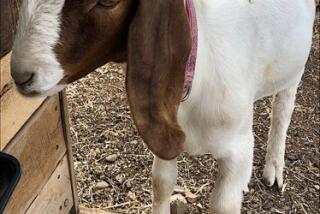Exotic animal laws called into question after Ohio killings
After the shooting stopped and panic subsided, only a monkey was still at large.
The death toll was 49. The carnage included one baboon, six black bears, eight lionesses and 18 rare Bengal tigers. The owner of the private menagerie was also dead. He apparently shot himself after loosing the wild animals on a small community in rural Ohio.
“It’s like Noah’s ark wrecking right here in Zanesville, Ohio,” said Jack Hanna, a former director of the Columbus Zoo.
PHOTOS: Dangerous exotic animals
But residents and animal activists nationwide didn’t speak of this sad story in Old Testament terms. For them, it was a very modern tale of inadequate laws, a night of terror, and innocent animals killed by reluctant authorities who felt they had no other choice.
The first complaint came into the Muskingum County Sheriff’s Office at 5:30 p.m. Tuesday. An animal had wandered off Terry Thompson’s exotic animal farm near the interstate. Then came another call — another sighting.
Since 2004, there had been at least three dozen complaints about Thompson’s animals on the loose: a giraffe grazing by a highway, a monkey in a tree. Typically, Thompson was fined $75. He’d also faced more serious charges of animal mistreatment. Recently, he had served a year in federal prison for gun possession and was ordered confined to his home for a year.
By the time deputies arrived at his 73-acre farm Tuesday evening, Thompson, 62, was dead. He had cut open pens and unlocked the farm gates. The tigers, black bears and lions were out, along with two wolves, a baboon, a monkey, three mountain lions and two grizzly bears.
Sheriff’s deputies, who discovered Thompson’s body in the driveway, were suddenly face to face with lions and grizzlies.
“I had deputies that had to shoot animals with their side arms,” said Muskingum County Sheriff Matt Lutz.
Overnight, nearly 50 armed officers headed out in a driving rain, searching the area around the farm. Some wore night goggles to better spot animals that might be hiding among the trees. The zoo in Columbus, about 55 miles west of Zanesville, sent veterinarians with tranquilizer guns.
In one harrowing incident, Lutz said, there wasn’t time to wait for a tranquilizer to take effect:
“We just had a huge tiger, an adult tiger that must’ve weighed 300 pounds, that was very aggressive. We got a tranquilizer in it, and this thing just went crazy.”
And it was shot.
Word quickly spread that Thompson, well known to locals as a strange man with an obsession for exotic animals, had set his menagerie free. Schools in the area were closed Wednesday and parents were warned to keep a close watch on their kids.
When Terri Wolfe, who works at the county animal shelter, heard the news, she immediately called her son, who has boys ages 4 and 6 who are “very curious little guys.”
“Terry Thompson’s animals are on the loose!” Wolfe recalled telling him. “Make sure you keep the grandkids in!”
By Wednesday morning, 49 of Thompson’s 56 animals were dead and buried on his property at the request of his distraught wife. Authorities had captured a grizzly, three leopards and two monkeys, and the animals were on their way to the Columbus Zoo for safekeeping. The monkey, which might be carrying hepatitis B, was still missing.
Almost 24 hours since that first 911 call to his office, Sheriff Lutz described his deputies as exhausted and overwhelmed.
“We didn’t go to the academy and get trained on how to deal with ... Bengal tigers,” he said.
But citizens should feel safe, he added.
Residents were well aware of Thompson’s sprawling hillside property near Interstate 70, where drivers could catch a glimpse of camels and llamas roaming “like they were cows and horses,” Wolfe said. That frustrated some people, particularly since Thompson’s backyard zoo was a few miles from a high school, but they had no way to make him close it down.
He was described as fiercely proud of his exotic creatures and fond of showing them off. In 2007 he was asked to leave a local pet fair when he showed up with a bear and lion cubs, Wolfe said. The next year, organizers had to specify that only domestic animals were invited.
He was perceived as dangerously eccentric, if not unpredictable. When Thompson purchased a Corvette convertible from Wolfe a few years ago, he arrived in a helicopter to pick it up. “That was pretty odd,” she said.
Then, in June 2008, the Bureau of Alcohol, Tobacco, Firearms and Explosives raided his property, seizing more than 100 guns. Thompson pleaded guilty to two federal charges and served a year in prison.
In the wider animal sanctuary movement, Ohio is known for inadequate regulation when it comes to exotic animals. It ranks on the bottom with Missouri, Nevada and Oklahoma among 25 states that have few if any rules on the keeping of wild animals, according to a 2009 report by the Humane Society of the United States.
“People die as a consequence of our reckless attachment to dangerous exotic animals,” said Wayne Pacelle, president and chief executive of the humane society. “Now animals are dead because of an awful absence of policy in Ohio.”
Pacelle called on the Ohio governor to immediately adopt a ban on private ownership of exotic animals.
Even Zanesville residents were confused about who should be in charge of animals that are usually seen in a zoo from a safe distance.
On Wednesday, Wolfe said she fielded phone calls from terrified people asking why the shelter where she worked couldn’t round up all the exotic animals. Over and over, Wolfe told them: “We deal with domestic stuff. Cats. Dogs. Not bears.”
PHOTOS: Dangerous exotic animals
Times researcher Scott Wilson contributed to this report.
More to Read
Start your day right
Sign up for Essential California for news, features and recommendations from the L.A. Times and beyond in your inbox six days a week.
You may occasionally receive promotional content from the Los Angeles Times.







